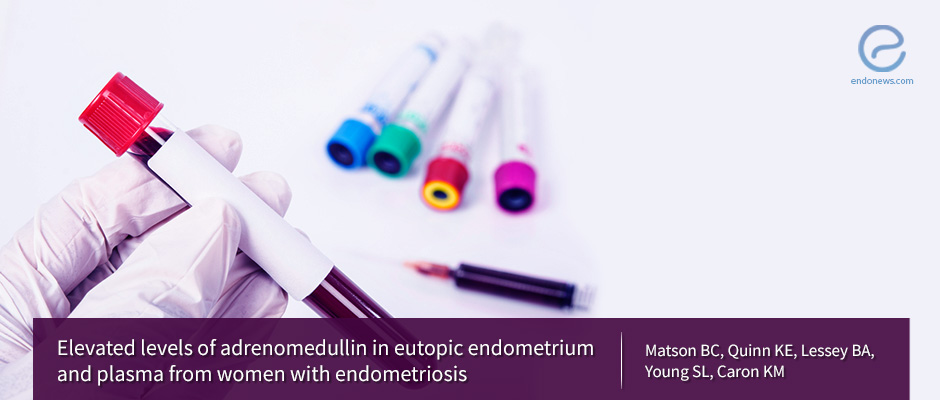Elevated levels of adrenomedullin in eutopic endometrium and plasma from women with endometriosis.
Jun 25, 2018
Adrenomedullin as a biomarker of endometriosis.
Key Points
Objectives:
- To test adrenomedullin (Adm, ADM) as a downstream target of signal transducer and activator of transcription 3 (STAT3) in endometrial cells.
- To test midregional proadrenomedullin (MR-proADM) as a biomarker of endometriosis.
Background:
- Recently, Kim et al. and others demonstrated that the IL-6–STAT3–HIF1A pathway is strongly implicated in the pathophysiology of endometriosis.
- Both STAT3 and HIF1A have been previously identified as regulators of the versatile peptide hormone ADM.
- In endometriosis, many data imply that ADM may be able to serve as a biomarker of endometriosis.
- In this study, Dr. Caron group from the University of North Carolina test the hypothesis that MR-proADM, as a surrogate for ADM potentially downstream of the IL-6–STAT3 axis, can serve as a biomarker of endometriosis.
Key results:
- Activation of STAT3 by IL-6 up-regulated Adm mRNA expression in an endometrial cell line, Ishikawa cell.
- ADM protein levels were elevated in the eutopic endometrium of women with endometriosis.
- MR-proADM concentrations were higher in women with endometriosis but were not correlated with disease stage, corrected by surgery, or predictive of fertility outcome.
Conclusions:
- Dr. Caron group suggests that MR-proADM may be able to serve as a biomarker of endometriosis, but it is unknown whether elevated MR-proADM levels are secondary to the estrogenic and inflammatory properties of endometriosis or an inciting pathogenic factor.
Lay Summary
Endometriosis is a common gynecologic disease characterized by the presence of endometrial tissue outside of the eutopic endometrium, commonly in the peritoneum of the pelvis and in pelvic organs, and often causing scarring and pain. The nonspecific nature of endometriosis symptoms makes the disease difficult to diagnose, and confident diagnosis usually requires visualization of ectopic lesions during surgical exploration.
Recently, Kim et al. and others demonstrated that the IL-6–STAT3–HIF1A pathway is strongly implicated in the pathophysiology of endometriosis. Both STAT3 and HIF1A have been previously identified as regulators of the versatile peptide hormone adrenomedullin (Adm, ADM). In endometriosis, many data imply that ADM may be able to serve as a biomarker of endometriosis. In this study, Dr. Caron group from the University of North Carolina test the hypothesis that MR-proADM, as a surrogate for ADM potentially downstream of the IL-6–STAT3 axis, can serve as a biomarker of endometriosis.
For this study, fifteen patients with endometriosis and 11 healthy control subjects donated eutopic endometrial biopsies. Also, for MR-proADM analysis, plasma from 28 patients with endometriosis and 19 healthy control subjects were used.
Activation of STAT3 by IL-6 up-regulated Adm mRNA expression in an endometrial cell line, Ishikawa cell. ADM protein levels were elevated in the eutopic endometrium of women with endometriosis. MR-proADM concentrations were higher in women with endometriosis but were not correlated with disease stage, corrected by surgery, or predictive of fertility outcome.
In conclusion, Dr. Caron group suggests that MR-proADM may be able to serve as a biomarker of endometriosis. However, it is not clear whether elevated MR-proADM levels are secondary to the estrogenic and inflammatory properties of endometriosis or an inciting pathogenic factor.
Research Source: https://www.ncbi.nlm.nih.gov/pubmed/?term=29871794
Adrenomedullin Endometriosis Midregional proadrenomedullin

